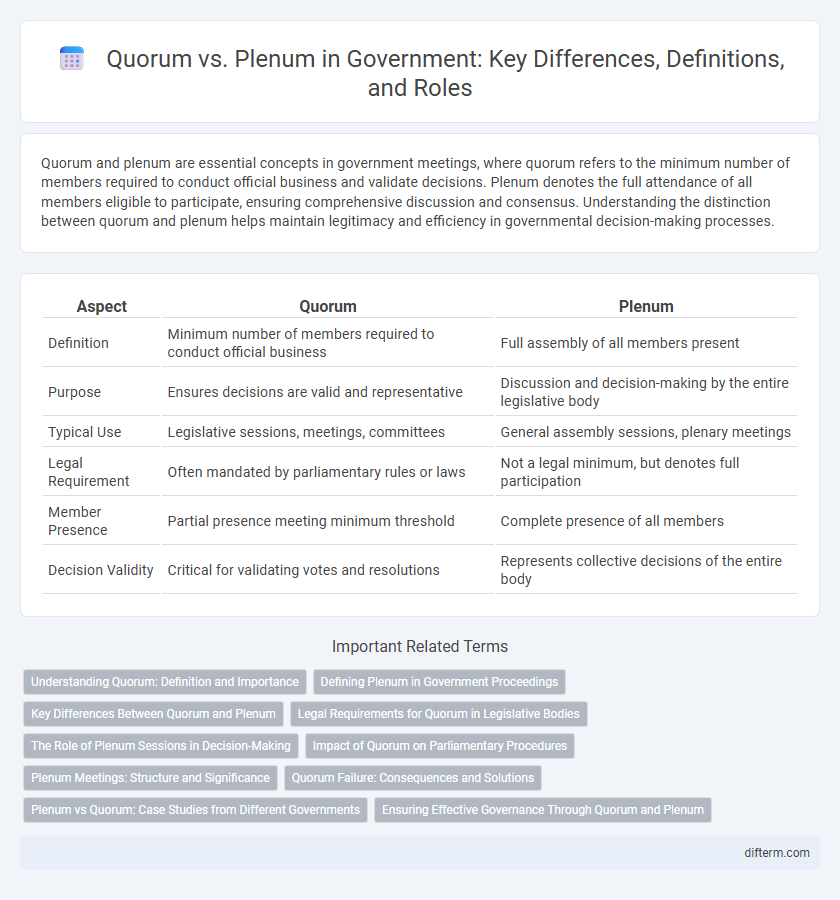Quorum and plenum are essential concepts in government meetings, where quorum refers to the minimum number of members required to conduct official business and validate decisions. Plenum denotes the full attendance of all members eligible to participate, ensuring comprehensive discussion and consensus. Understanding the distinction between quorum and plenum helps maintain legitimacy and efficiency in governmental decision-making processes.
Table of Comparison
| Aspect | Quorum | Plenum |
|---|---|---|
| Definition | Minimum number of members required to conduct official business | Full assembly of all members present |
| Purpose | Ensures decisions are valid and representative | Discussion and decision-making by the entire legislative body |
| Typical Use | Legislative sessions, meetings, committees | General assembly sessions, plenary meetings |
| Legal Requirement | Often mandated by parliamentary rules or laws | Not a legal minimum, but denotes full participation |
| Member Presence | Partial presence meeting minimum threshold | Complete presence of all members |
| Decision Validity | Critical for validating votes and resolutions | Represents collective decisions of the entire body |
Understanding Quorum: Definition and Importance
Quorum refers to the minimum number of members required to be present for a legislative body or meeting to conduct official business, ensuring decisions represent a legitimate majority. This threshold, often a simple majority of total members, prevents actions from being taken without adequate representation and upholds the integrity of the governing process. Understanding quorum is crucial because it safeguards democratic principles by mandating sufficient participation before votes or resolutions are enacted.
Defining Plenum in Government Proceedings
Plenum in government proceedings refers to a session or meeting in which all members of a legislative or decision-making body are present, ensuring full representation for comprehensive discussion and voting on policies. Unlike a quorum, which is the minimum number of members required to conduct official business, a plenum guarantees that every member participates, providing legitimacy and inclusiveness to the decisions made. This concept is crucial in parliamentary systems where unanimous or majority consensus requires the active involvement of the entire assembly.
Key Differences Between Quorum and Plenum
Quorum refers to the minimum number of members required to be present for a legislative body to conduct valid business, ensuring decisions represent a legitimate majority. Plenum denotes a session where all members of the body are present, allowing for full participation and comprehensive debate on matters. The key difference lies in quorum setting the threshold for valid proceedings, while plenum involves the total assembly's attendance and engagement.
Legal Requirements for Quorum in Legislative Bodies
A quorum represents the minimum number of members required to legally conduct business in legislative bodies, ensuring decisions reflect a valid consensus. Plenum refers to the full assembly of all members present, often used for significant votes or debates requiring entire membership participation. Legal requirements for quorum vary by jurisdiction but typically mandate a majority or fixed proportion of members be present to legitimize proceedings and prevent actions without adequate representation.
The Role of Plenum Sessions in Decision-Making
Plenum sessions serve as the comprehensive gatherings where all members of a legislative or governmental body convene to deliberate and formalize key policy decisions. Unlike quorum, which denotes the minimum number of members required for a meeting to proceed, plenum ensures full representation, enabling inclusive debate and authoritative voting on legislative matters. The role of plenum sessions in decision-making is pivotal for legitimizing resolutions and fostering consensus across diverse political factions within government institutions.
Impact of Quorum on Parliamentary Procedures
Quorum is the minimum number of members required to validate the proceedings of a parliamentary session, ensuring decisions reflect a legitimate representation of the assembly. The absence of a quorum halts decision-making processes, preventing the adoption of motions or legislation and maintaining procedural integrity. Plenum, contrastingly, refers to the full assembly, whose presence guarantees comprehensive deliberation but is not always necessary for routine operations.
Plenum Meetings: Structure and Significance
Plenum meetings refer to full assemblies where all members of a governing body or legislative chamber are present, enabling comprehensive debate and decision-making. These sessions hold critical significance as they validate legislative actions by ensuring decisions represent the collective will of the entire membership. The structured format of plenary sessions promotes transparency, accountability, and thorough discussion of policies before enactment.
Quorum Failure: Consequences and Solutions
Quorum failure in government results in the inability to conduct official proceedings, delaying legislative decisions and halting the passage of critical laws. This paralysis undermines governance, causing inefficiencies and potential legal challenges to enacted policies. Solutions include implementing quorum rules enforcement, using proxy voting, and scheduling meetings to maximize attendance, ensuring sufficient member presence for valid decision-making.
Plenum vs Quorum: Case Studies from Different Governments
Plenum and quorum represent distinct procedural concepts in legislative bodies; a plenum refers to the entire membership present during a session, while a quorum denotes the minimum number required to validate proceedings. Case studies from the U.S. Congress and the German Bundestag illustrate how plenums enable comprehensive debate and decision-making, whereas quorums ensure legal legitimacy in votes and motions. Variations in quorum thresholds and plenum utilization reflect differing governance structures and impact legislative efficiency and accountability across governments.
Ensuring Effective Governance Through Quorum and Plenum
Quorum establishes the minimum number of members required to conduct official government meetings, ensuring legitimacy and decision-making authority. Plenum refers to the full assembly of all members, enabling comprehensive debate and collective agreement on policies. Balancing quorum and plenum is essential for effective governance, promoting both operational efficiency and inclusive representation.
Quorum vs Plenum Infographic

 difterm.com
difterm.com